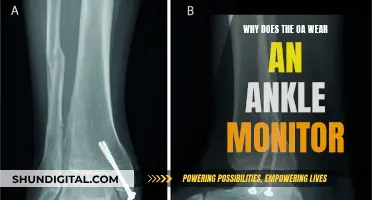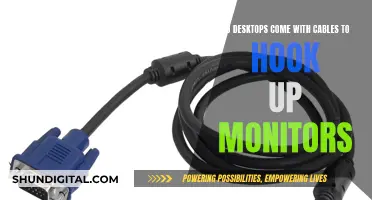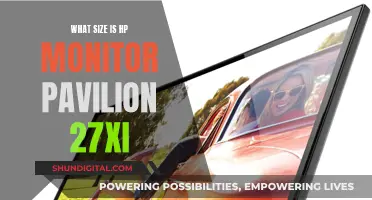
Blind spot monitoring systems are becoming increasingly common in cars, with the technology now available at every price point. These systems use sensors, cameras, radar, or ultrasonic sensors to detect vehicles in a car's blind spot, warning the driver through visual, audio, or tactile alerts. Some cars even have a Blind Spot Assist function, which may correct the steering wheel or apply the brakes to avoid a collision. Blind spot monitoring is considered one of the most important safety features in modern vehicles, which tend to have larger side and rear blind spots. Some of the cars that have blind spot monitoring include the Toyota Prius, Nissan Sentra, Honda Accord, Hyundai Elantra, Ford Mustang, Chevrolet Malibu, Kia Stinger, Audi A3, Mercedes-Benz A-Class, BMW 2 Series, Kia Telluride, Honda Odyssey, Honda CR-V, Chevrolet Bolt, and Subaru Forester.
What You'll Learn
- Blind Spot Monitoring (BSM) systems use cameras, radar, and/or ultrasonic sensors to detect vehicles in a driver's blind spot
- BSM systems warn drivers through visual, auditory, or tactile alerts
- Blind Spot Assist (BSA) systems automatically steer or brake to avoid collisions when changing lanes
- BSM is now available at every price point and in various types of cars, from hybrids to sports cars
- BSM is considered a critical safety feature by many drivers, who say it has prevented crashes and reduced driving stress

Blind Spot Monitoring (BSM) systems use cameras, radar, and/or ultrasonic sensors to detect vehicles in a driver's blind spot
Blind Spot Monitoring (BSM) systems are an increasingly common feature in modern cars, offering enhanced safety by detecting vehicles in a driver's blind spot. These systems utilise a combination of cameras, radar, and/or ultrasonic sensors to scan the vehicle's flanks for obstacles. When a vehicle enters the blind spot, or rapidly approaches it from behind, drivers are typically alerted through visual, audible, or tactile means. Visual warnings often appear as illuminated icons on side mirrors or near them, while audible alerts may include chimes, and tactile alerts could involve shaking the steering wheel.
BSM systems can be categorised into two types: Blind Spot Warning (BSW) and Blind Spot Assist (BSA). BSW notifies drivers of vehicles in their blind spot, sometimes providing additional warnings if the driver activates the turn signal when it is unsafe to merge. On the other hand, BSA takes a more active role by automatically steering or braking to avoid a potential collision when the turn signal is activated and an object is detected in the blind spot.
The effectiveness of BSM systems in preventing crashes and reducing driving stress has been emphasised by car owners. In surveys, two-thirds of drivers using BSW reported that it helped them avoid accidents. This technology is now widely available across various car models, price points, and brands, including Toyota, Nissan, Honda, Hyundai, Ford, Chevrolet, Audi, BMW, Kia, and Mercedes-Benz.
When choosing a vehicle with BSM, it is recommended to select one that offers customisable sensitivity and warning types. Visual warnings in side mirrors are often preferred over dashboard alerts as they are less distracting. Additionally, accessing the owner's manual or the "owner's" section on the automaker's website can provide valuable insights into the specifics of the BSM system.
Troubleshooting Black-Screen Issues on LCD Monitors
You may want to see also

BSM systems warn drivers through visual, auditory, or tactile alerts
Blind Spot Monitoring (BSM) systems are designed to warn drivers when there is a vehicle in their blind spot, helping to prevent accidents when changing lanes. BSM systems use sensors to monitor the roads and detect oncoming vehicles. When something enters the driver's blind spot, the technology will warn the driver through visual, auditory, or tactile alerts.
Visual alerts are the most common form of warning, with many BSM systems illuminating a light on or near the side-view mirror. Some systems will also display a red icon on the side-view mirror, or a flashing indicator to warn of a potential collision. The Kia Drive Wise package takes this a step further, with a Blind Spot View Monitor that shows digital footage of the driver's blind spot on the display panel.
Auditory alerts are also used by BSM systems, with some sounding a chime or beep when a vehicle is detected in the blind spot. This is often used in conjunction with a visual alert, and in some cases, the system will emit a warning sound if the driver activates their turn signal when a vehicle is detected.
In addition to visual and auditory alerts, some BSM systems use tactile warnings to get the driver's attention. These haptic alerts trigger vibrations through the steering wheel or the driver's seat to issue a warning.
While BSM systems are becoming increasingly common across a range of vehicle price points, it's important to note that they should not be solely relied upon to prevent accidents. Drivers should continue to follow best practices and check their blind spots manually before changing lanes or merging.
Powering LCD Monitors: Portable Power Bank Solutions
You may want to see also

Blind Spot Assist (BSA) systems automatically steer or brake to avoid collisions when changing lanes
Blind Spot Assist (BSA) systems are an increasingly common feature in modern cars, enhancing driver safety by mitigating the risks associated with blind spots. While initially exclusive to luxury vehicles, BSA systems are now accessible across a range of price points. These systems employ sensors, cameras, radar, or ultrasonic sensors to detect vehicles in the driver's blind spot, providing both visual and auditory alerts to warn of potential collisions.
BSA systems are designed to automatically intervene by steering or braking to avoid collisions when changing lanes. For instance, the Land Rover Defender's BSA system applies corrective steering inputs when it detects a vehicle in the blind spot area during a lane change attempt. This system operates independently of turn signal usage and can be overridden by the driver if necessary. However, it is important to note that the BSA system has limitations, such as not functioning when the vehicle is in reverse or park, or when the brake pedal is pressed. Additionally, it may not operate accurately in adverse weather conditions or if the sensors are obstructed or misaligned.
Hyundai's Blind-Spot Collision-Avoidance Assist, available on most models, also actively intervenes by providing active warnings, such as flashing mirror indicators, audible warning tones, or vibrations in the steering wheel, if the driver attempts to change lanes with a vehicle in their blind spot. These warnings aim to prevent potential collisions and can be customized or turned off based on driving conditions.
The inclusion of BSA systems in vehicles like the Land Rover Defender and Hyundai models underscores the growing trend towards incorporating advanced driver-assistance features that enhance safety on the road. These systems empower drivers with valuable tools to mitigate blind spot risks and make more informed decisions while changing lanes.
Overall, Blind Spot Assist (BSA) systems that automatically steer or brake to avoid collisions when changing lanes represent a significant advancement in automotive safety. By intervening through steering or braking actions, these systems provide an extra layer of protection for drivers, reducing the likelihood of accidents caused by blind spots. As technology continues to evolve, it is expected that BSA systems will become even more sophisticated and prevalent, making the driving experience safer and less stressful.
Electricity Usage: Monitored by Companies or Not?
You may want to see also

BSM is now available at every price point and in various types of cars, from hybrids to sports cars
Blind Spot Monitoring (BSM) is now available in almost every type of car, from hybrids to sports cars, and across all price points.
BSM is no longer a feature exclusive to luxury vehicles. It is now common at every price point and in a wide range of cars. The technology uses sensors to detect objects in a driver's blind spot, and alerts the driver with a visual or audio warning, or even by steering the car back into its lane.
For those looking for a hybrid with BSM, the Toyota Prius and Honda Accord are both well-known options. The Prius has a hatchback design, giving added versatility for cargo, while the Accord comes in both gas and hybrid engine options. Both cars offer BSM with a rear cross-traffic alert feature.
For those wanting something more affordable, the Nissan Sentra offers standard BSM as part of its Nissan Safety Shield 360 package, which also includes automatic emergency braking and lane departure warning.
If you're in the market for a sports car, the Ford Mustang includes BSM as a standard feature. The Mustang has a wide range of trims, from modest engines to high-performance options, and both hardtop and soft-top convertible body styles.
BSM is also available in other types of cars, such as sedans, SUVs, and coupes, showing its versatility and widespread adoption across the automotive industry.
Monitoring Internet Usage: Router Settings for Parents and Administrators
You may want to see also

BSM is considered a critical safety feature by many drivers, who say it has prevented crashes and reduced driving stress
Blind spot monitoring (BSM) is a critical safety feature that can help prevent crashes and reduce driving stress. It is designed to assist drivers in detecting vehicles, pedestrians, or cyclists in their blind spots, thereby reducing the risk of collisions and increasing driving awareness. BSM systems use sensors, cameras, or a combination of both, to monitor a vehicle's blind spots and provide alerts to the driver.
The alerts can come in the form of visual, auditory, or haptic warnings. Visual alerts may include illuminating a light in the side-view mirror or displaying a live feed of the blind spot on the instrument cluster or infotainment screen. Auditory alerts typically involve a chime or beep, while haptic feedback may be in the form of a vibration through the steering wheel. Some systems even take corrective action by steering the vehicle back into its lane or applying the brakes if the driver attempts to change lanes when another object is in the blind spot.
BSM is particularly useful when driving larger vehicles, where visibility is more limited, and when driving on busy roads or highways with multiple lanes of traffic. By providing drivers with additional information about their surroundings, BSM reduces the risk of lane change or merging manoeuvres that could result in a collision. This is especially important for vulnerable road users, such as pedestrians and cyclists, who may be difficult for drivers to spot and are at a higher risk of severe or fatal injuries in crashes with heavy goods vehicles or buses.
In addition to increasing safety, BSM can also reduce driving stress. Knowing that the system is actively monitoring the vehicle's blind spots can provide drivers with peace of mind and help them feel more confident and in control while driving. This is particularly beneficial for those who frequently drive in heavy traffic or challenging road conditions.
While BSM is a valuable safety feature, it is important to note that it does not replace the need for drivers to remain cautious and actively check their blind spots. Drivers should always be attentive and use their mirrors and surroundings to make informed decisions. However, with the help of BSM, drivers can benefit from increased awareness, reduced stress, and a lower risk of crashes.
Plasma Monitors: Large Screens, Commercial Availability
You may want to see also
Frequently asked questions
Blind spot monitoring is a system that uses sensors, cameras, radar, or ultrasonic sensors to detect vehicles in a car's blind spot. It warns the driver through visual, audible, or tactile alerts, and some systems even steer the car back into its lane or apply the brakes to avoid a collision.
Many cars across different price points now offer blind spot monitoring as a standard or optional feature. Some examples include the Nissan Sentra, Hyundai Elantra, Kia Stinger, and BMW 2 Series.
Blind spot monitoring systems use sensors, cameras, radar, or ultrasonic sensors to detect vehicles in the blind spot. When a vehicle is detected, the technology warns the driver through visual alerts, such as illuminating a light in the side-view mirror, or audible/tactile alerts like a chime or steering wheel vibration.
Yes, some blind spot monitoring systems allow drivers to customize the sensitivity and type of warning. For example, you can set the system to give only a visual warning and reserve louder audio warnings for imminent collisions.
The cost of adding blind spot monitoring to your car can vary depending on the make and model of your vehicle, as well as the specific features included in the system. It's best to check with your car dealer or manufacturer to get an accurate quote for your particular vehicle.







